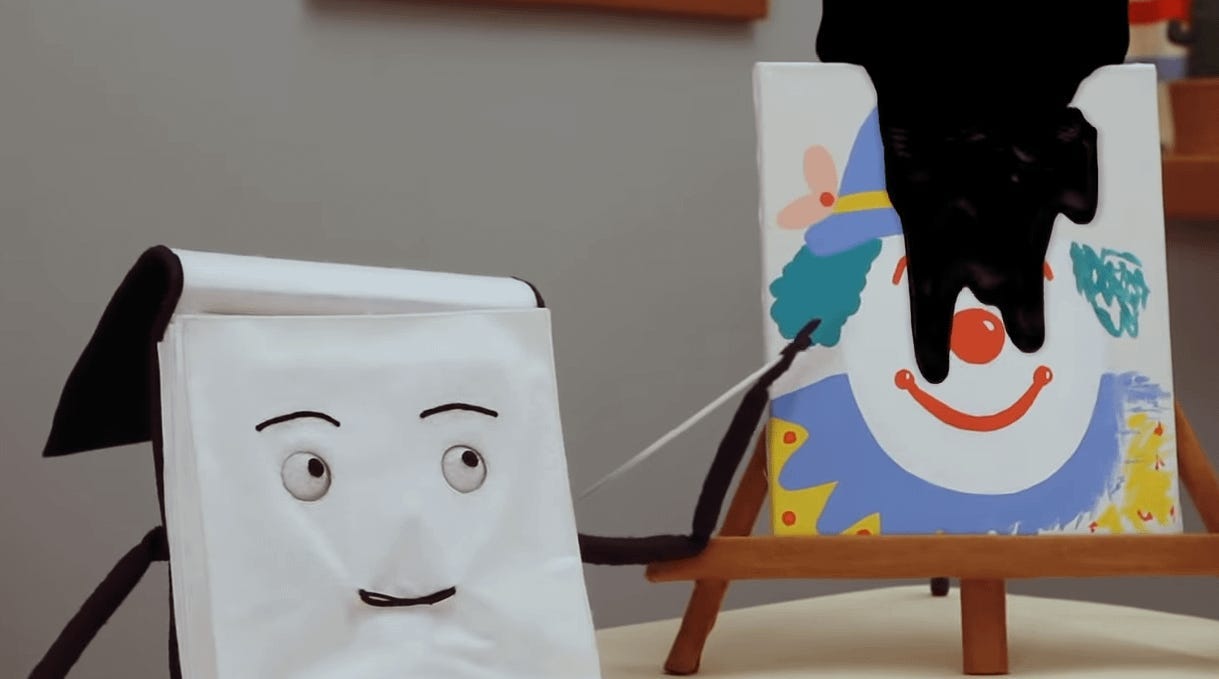Don’t Hug Me I’m Scared: A Surreal Commentary on Creativity and Conformity
Becky Sloan and Joseph Pelling's dark and brilliant exploration of creativity, control, and the media’s hidden influence.
Don't Hug Me I'm Scared defies the “normal” standard and exceeds any conventional categorisation, standing out as a groundbreaking exploration of the media's power to both comfort and disturb. Presented as a quirky internet show, Don’t Hug Me I’m Scared is a striking piece of surrealist art taps into dark satire and psychological horror, as it explores themes of control, the impact of media on our perception, and the paradox of 'learning' through restrictive, pre-determined narratives and capturing the tension between innocence as well as the loss of innocence, in ways that resonate deeply with modern audiences.
The Dark Symbolism of Puppetry
Growing up, we all experienced that rush of excitement to watch our favourite shows, more particularly, I am sure that we all have watched and enjoyed shows like Sesame Street, Blue’s Clues, and The Muppets. These shows became nostalgic cornerstones, remembered for their cheerful simplicity and predictable “formulas”, where each episode introduced a conflict, taught a lesson through song or a montage, and wrapped everything up with a positive message. DHMIS borrows this “formula,” and draws heavily from the aesthetic and format of classic children’s TV shows. The series begins with bright colours, puppets, upbeat songs, and a "lesson" structure that anyone familiar with educational programming would recognize. This flawlessly emulates the style and structure of beloved children's shows. On the surface, DHMIS uses the comforting setup of children’s television as a guise—a world filled with colourful puppets, catchy songs, and moral lessons. Yet, it weaponises this format to explore how seemingly 'innocent' educational tools can subtly manipulate and control.
From the very first episode, DHMIS subverts viewer expectations. Each episode introduces a "teacher," like the talking Notebook in Episode 1, who leads the main characters in a lesson that starts out innocently. Lessons on "how to be creative" or "understanding time" quickly shift from educational to bizarre and oppressive. The Notebook's restriction, "Green is not a creative colour," for instance, is more than just an absurdity; it reflects how media can narrow down creativity and freedom under the guise of 'teaching.' The lesson becomes more of a command than guidance, skewering how children's programming can sometimes limit thought rather than expand it.
This shift from innocence to manipulation reflects the idea of media control, where seemingly harmless programs can reinforce conformity and discourage genuine individuality.
The Use Of Puppetry
Puppetry in Don't Hug Me I'm Scared isn’t just an aesthetic choice; it’s a metaphor for the loss of autonomy. While older shows like The Muppets used puppets as free-spirited, independent characters, DHMIS subverts this by presenting puppets as symbols of constraint and manipulation. The main characters are constantly subjected to the whims of unseen forces, often with limited agency or freedom. This exaggeration of the children’s television style turns a nostalgic visual into a chilling reminder of control, as the puppets are rendered powerless within their environments. It’s as if the characters are meant to reflect the lack of agency we can feel under societal or media influence.
The show's take on horror becomes evident here too. The use of puppets in horror typically evokes a feeling of the uncanny—a combination of familiarity and eerie otherness. This taps into our inherent discomfort with things that are 'almost' human, emphasising how the show’s characters, while vibrant and friendly on the surface, are ultimately controlled and manipulated.
Mixing Genres and Blurring Reality
DHMIS blends genres through pastiche, combining children’s television, horror, surrealism, and even dark comedy. This genre-hopping keeps viewers on edge, as they never know whether to laugh, cringe, or be disturbed. The series destabilises viewers by constantly shifting between comfort and fear, humour and horror. This genre-blurring mirrors the unpredictable nature of modern media, where boundaries are constantly crossed, placing its audience in a state of unease. What starts as comedy or an educational skit often morphs into something grotesque and unsettling, reflecting the unpredictability of the media's influence and the way it can warp perceptions.
A Commentary on Creativity and Control
The creators of DHMIS, skillfully pay tribute to the innocent charm of children’s television while using that style to explore much darker, existential themes. This layered approach to pastiche allows the series to feel familiar yet unsettling—capturing the chaotic, sometimes contradictory messages in media and society. Beyond mere imitation, the show becomes a lens through which viewers see the darker sides of creativity, conformity, and manipulation. The series doesn’t just mock; it interrogates how media, authority, and even culture shape perceptions and exert control over ideas and individuals alike.
More than just being a commentary on children, Don't Hug Me I'm Scared also critiques the children who became adults—us—and the constrained, stifled nature of creativity in adulthood. As we grow older, the boundless imagination of childhood becomes boxed in by societal expectations, professional pressures, and the rigid frameworks of what is deemed 'acceptable.' The series reflects this tension, showing how the freedom to be creative is slowly chipped away, replaced by rules and systems that dictate how we should think, act, and even dream.
In the end, Don't Hug Me I'm Scared acts as a surreal commentary on the blurred lines between entertainment and instruction, reality and performance. It forces viewers to confront unsettling truths about their autonomy, posing the question: how much of what we know, believe, or create is truly our own? Through its unique voice, style and cinematography, it compels us to examine how our 'learning' and, by extension, our identities—have been shaped by forces beyond our control, challenging us to reclaim the lost art of thinking freely.





